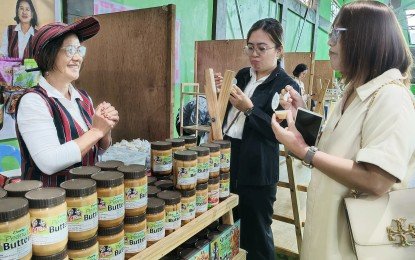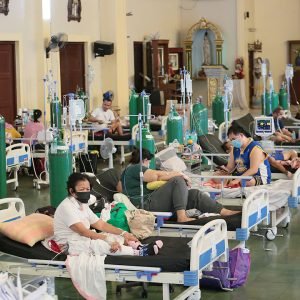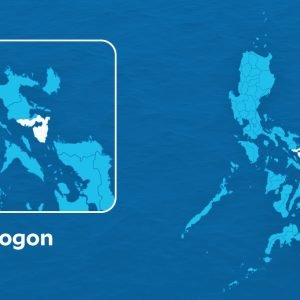
GOVT ASSURES PUBLIC ON STABLE COMMODITY PRICES
The government remains committed to stabilizing the prices of commodities, according to the National Economic and Development Authority (NEDA).
“The continued slowdown in inflation is expected to boost consumer confidence, driving higher spending and consumption and fueling business expansion,” said NEDA Secretary Arsenio Balisacan, after the Philippines Statistics Authority (PSA) reported on Oct. 4 the lower 1.9% inflation rate for September.
“Additionally, easing food prices will relieve low-income households, enabling them to allocate more to other essential needs such as education and health. We will sustain the momentum as we assure the public that we will continue to pursue and carry out strategies to maintain stable prices of food and other commodities,” he added.
Balisacan said the Executive Order issued by President Ferdinand R. Marcos Jr., which reduced the tariffs on imported rice to 15%, helped bring down prices of the staple.
“While we expect lower tariffs to reduce rice prices, we should continuously support local production through increased agricultural funding to complement this short-term measure,” Balisacan said.
He added that the government is ready to address other inflationary pressures affecting food, such as the continuing prevalence of African swine fever (ASF), through the delivery of vaccines to affected areas.
Also, the signing of the Anti-Agricultural Economic Sabotage Act, which aims to eradicate hoarding, anti-competitive practices, and other illegal activities, will also ensure access to affordable food.
“With the passage of this law, we protect our farmers and, at the same time, ensure that every Filipino has access to affordable food, which is vital in protecting the most vulnerable members of society while we work toward achieving inclusive economic progress,” Balisacan said.
RENEWABLE ENERGY PROJECTS DOMINATE GREEN LANE LIST
The “green lane” or One-Stop Action Center for Strategic Investments (OSAC-SI) of the Board of Investments (BOI) continue to receive renewable energy (RE) projects to facilitate faster the processing of documentary requirements.
Speaking at the maiden Renewable Energy Forum organized by the Economic Journalists Association of the Philippines (EJAP) and Aboitiz Power Corp. at the Securities and Exchange headquarters in Makati on Oct. 4, BOI Director Ernesto Delos Reyes Jr. said 128 RE projects comprised the 158 projects that received green lane endorsement in the first nine months of the year.
He said the 128 RE projects that were certified as strategic investments from January to September have a total capital of P3.91 trillion, and about P1.29 trillion are foreign equity.
Overall, the 158 projects certified for green lane facilitation amounted to P4.3 trillion, comprised of six digital infrastructure projects with P346.33 billion in investments, 22 food security projects worth P13.5 billion, and two manufacturing projects amounting to P29.61 billion.
“Since RE projects have long gestation periods, most of the green lane projects we have certified are still in their pre-development stage. But as of September 2024, two projects are already starting their commercial operations,” Delos Reyes said.
“One of which is the Cayanga-Bugallon Solar Project in Pangasinan whose ERC (Energy Regulatory Commission) approval has been facilitated through the Green Lanes. The Calabanga Renewable Energy Project is already operating and with the Green Lane endorsement, their permits are also expedited,” she added.
AMRO SEES PH ECONOMIC GROWTH HITTING 6% IN 2025
Government spending and the growth in services exports will drive Philippine economic growth to reach over 6% this year and in 2025, according to the ASEAN+3 Macroeconomic Research Office (AMRO).
In the latest October 2024 ASEAN+3 Regional Economic Outlook update released on Oct. 3, AMRO maintained its Philippine economic growth outlook at 6.1% for 2024 and 6.3% for 2025, or the second highest in the region, next to Vietnam’s 6.2% and 6.6% economic growth outlook for 2024 and 2025, respectively.
In a virtual briefing, AMRO chief economist Hoe Ee Khor said the forecast for the Philippines is “still among the strongest in the region.”
“We didn’t change the forecast for the Philippines. We expect growth to be 6.1% which will be an improvement from last year’s 5.6% and for next year, 6.3% and this is mainly because we expect government investment spending to be higher this year, together with services exports,” Khor said.
“So like most of the other countries, the Philippines went through a rough patch last year, the interest rate was pretty high. The governor has cut interest rates by 25 basis points, and it’s indicated for another cut later this month,” he added.
DTI JUSTIFIES 12% VALUE-ADDED TAX FOREIGN ONLINE SERVICES
The newly signed Republic Act (RA) 12023, imposing a 12% value-added tax (VAT) on online services from foreign providers, promotes an equitable digital economy in the country, acting Department of Trade and Industry (DTI) Secretary Ma. Cristina Roque said.
“This landmark legislation is a significant step towards creating a more equitable and inclusive digital economy in the Philippines. By ensuring that all digital service providers, regardless of origin, contribute their fair share to the country’s tax system, we are promoting healthy competition and supporting the growth of our local MSMEs (micro, small and medium enterprises),” Roque said on Oct. 3.
She added that RA 12023 eliminates the long-standing disparity where foreign digital service providers (DSPs) were exempted from the 12% VAT, giving them an “unfair advantage” over local players.
“This levels the playing field for our local MSMEs by removing the unfair advantage previously enjoyed by foreign digital service providers,” Roque said.
“With a more competitive landscape, our MSMEs can better leverage digital technologies to innovate, expand their reach, and thrive in the global marketplace,” she added.
IMF SEES PH ECONOMY GROWING BY OVER 6% THIS YEAR
The Philippine economy is expected to grow by over 6% next year, an International Monetary Fund (IMF) official said.
In a briefing at the Bangko Sentral ng Pilipinas office in Manila on Oct. 2, IMF Mission Chief Eli Arbatli Saxegaard said the Philippines remained among the best performing economies in the region, citing that the country’s economy successfully navigated multiple external headwinds in recent years.
She said that Philippine gross domestic product (GDP) is projected to grow by 5.8%this year and will further accelerate to 6.1% in 2025.
“This pick-up in growth will be supported by more accommodative financial conditions and higher investment,” Saxegaard.
The latest projection, however, was lower than the 6% and 6.2% previous forecast for 2024 and 2025, respectively.
“The downward revision from our July forecast reflects our view that private consumption is going to grow slightly with less momentum. So I would like to highlight that the downgrade is very small, 0.2, and reflects the fact that the first half (of the year) private consumption growth was lower than what we had anticipated. And this might be in part driven by the high food prices,” Saxegaard said.
BOI RECORDS SURGE IN CHINESE INVESTMENTS POURING INTO PH
Chinese investments into the Philippines is increasing, according to the Board of
Investments (BOI) despite the maritime row between the two countries.
The BOI said on Oct. 1 it approved over P1 billion worth of projects from Chinese sources from January to September this year, or 237% higher than the same period last year. This is also bigger than the BOI’s full-year projection for Chinese investments at P619 million.
Overall, China is the seventh-largest source of investment approvals this year.
To bring in more projects from China, the BOI sent a delegation to that country last month to promote the Philippines as an investment hub during the China International Fair for Investment and Trade (CIFIT) in Xiamen. This helped secure discussions with potential Chinese investors.
“Throughout the six days of the Investment Promotion Roadshow, we generated significant interest from various sectors. We conveyed to the investors that our goal is to transform the Philippine economy to enter a virtuous cycle of sustained economic growth,” Trade Undersecretary and BOI Managing Head Ceferino Rodolfo said.
“Events like this showcase the Philippines’ proposition as the Regional hub for smart and sustainable manufacturing and services industries, that will ultimately generate green and sustainable jobs for the Filipino people, which has been our primary objective,” he added.
PH MANUFACTURING SECTOR PUTS OUT GOOD PERFORMANCE
The country’s factories put up a good performance at the end of third quarter of the year, recording a 53.7 purchasing managers’ index (PMI), the highest since mid-2022, S&P Global Manufacturing PMI reported on Oct. 1.
The PMI in September 2024 was also stronger compared to the 51.2 index in August this year.
S&P Global Market Intelligence economist Maryam Baluch said sharp expansions in factory output and new orders were the factors for the significant improvement in the country’s manufacturing performance in September. And despite a drop from domestic orders, Baluch said the domestic demand buoyed the local industry.
“While weak international demand and supply chain issues will act as headwinds, robust domestic demand is expected to drive growth,” she said.
The survey said manufacturers also increased their hiring and purchasing activities amid higher production and heightened business confidence for the next 12 months.
D&L GETS READY FOR GOVERNMENT-MANDATED BIOFUEL MIX INCREASE
D&L Industries, Inc. is ready to repurpose its existing factory lines in Quezon City to cater to the higher biofuel demand in the country.
Chemrez Technologies Inc. president Dean Lao Jr. told reporters during a media tour at D&L’s new P10.5-billion factory in Tanauan, Batangas on Sept. 30 that its biofuel capacity is currently at 90 million liters, which only cater to a portion of the overall demand.
D&L is the parent company of Chemrez Technologies.
The demand for biofuel will further increase based on Department of Energy (DOE) Circular 2024-05-0014 took effect on Oct. 1, wherein all coco methyl ester (CME) blend for all diesel fuel should be at least 3 percent (B3) from the current 2 percent (B2).
This will translate to a 450-million-liter increase in biofuel demand.
Biodiesel mix will further increase to 4 percent (B4) on Oct. 1, 2025, and to 5 percent (B5) on Oct. 1, 2026.
“This directive from the DOE is a huge step towards progress and the development of the biodiesel and coconut industry in general,” Lao said.
(PHOTO FROM PNA)







